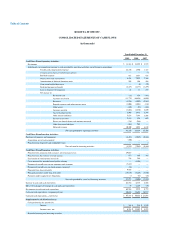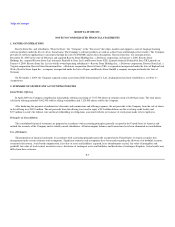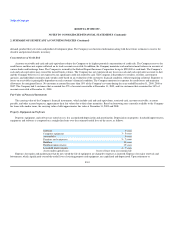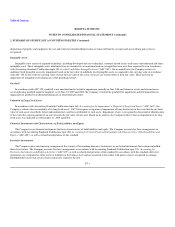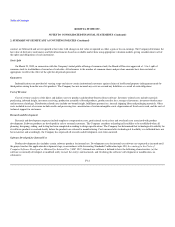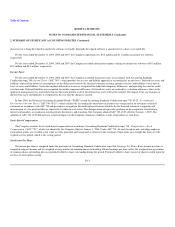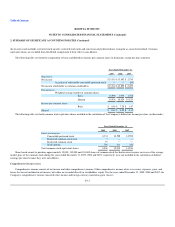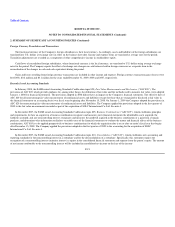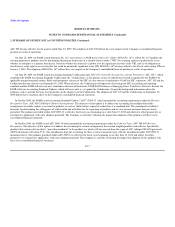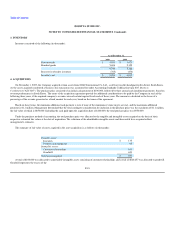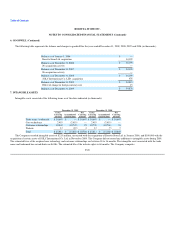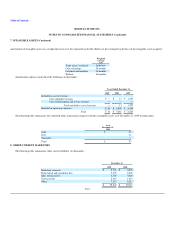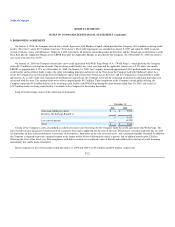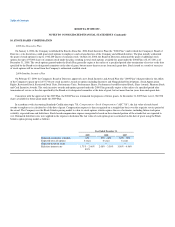Rosetta Stone 2009 Annual Report Download - page 89
Download and view the complete annual report
Please find page 89 of the 2009 Rosetta Stone annual report below. You can navigate through the pages in the report by either clicking on the pages listed below, or by using the keyword search tool below to find specific information within the annual report.
Table of Contents
ROSETTA STONE INC.
NOTES TO CONSOLIDATED FINANCIAL STATEMENTS (Continued)
2. SUMMARY OF SIGNIFICANT ACCOUNTING POLICIES (Continued)
plan exists or is being developed to market the software externally. Internally developed software is amortized over a three-year useful life.
For the years ended December 31, 2009, 2008 and 2007, the Company capitalized zero, $0.2 million and $1.1 million in internal-use software,
respectively.
For the years ended December 31, 2009, 2008 and 2007, the Company recorded amortization expense relating to internal-use software of $0.5 million,
$0.5 million and $0.4 million, respectively.
Income Taxes
For the years ended December 31, 2009, 2008 and 2007, the Company accounted for income taxes in accordance with Accounting Standards
Codification topic 740, Income Taxes ("ASC 740"), which provides for an asset and liability approach to accounting for income taxes. Deferred tax assets and
liabilities represent the future tax consequences of the differences between the financial statement carrying amounts of assets and liabilities versus the tax
bases of assets and liabilities. Under this method, deferred tax assets are recognized for deductible temporary differences, and operating loss and tax credit
carryforwards. Deferred liabilities are recognized for taxable temporary differences. Deferred tax assets are reduced by a valuation allowance when, in the
opinion of management, it is more likely than not that some portion or all of the deferred tax assets will not be realized. The impact of tax rate changes on
deferred tax assets and liabilities is recognized in the year that the change is enacted.
In June 2006, the Financial Accounting Standards Board ("FASB") issued Accounting Standards Codification topic 740-10-25, Accounting for
Uncertainty in Income Taxes ("ASC 740-10-25"), which clarifies the accounting for uncertainty in income taxes recognized in an enterprise's financial
statements in accordance with ASC 740 and prescribes a recognition threshold and measurement attribute for the financial statement recognition and
measurement of a tax position taken or expected to be taken in a tax return. This Interpretation also provides guidance on de-recognition, classification,
interest and penalties, accounting in interim periods, disclosures, and transition. The Company adopted ASC 740-10-25 effective January 1, 2007. The
adoption of ASC 740-10-25 did not have a material impact on the Company's financial condition, results of operations or cash flows.
Stock-Based Compensation
The Company accounts for its stock-based compensation in accordance Accounting Standards Codification topic 718, Compensation—Stock
Compensation ("ASC 718"), which was adopted by the Company effective January 1, 2006. Under ASC 718, all stock-based awards, including employee
stock option grants, are recorded at fair value as of the grant date and recognized as expense in the statement of operations on a straight-line basis over the
requisite service period, which is the vesting period.
Net Income Per Share
Net income per share is computed under the provisions of Accounting Standards Codification topic 260, Earnings Per Share. Basic income per share is
computed using net income and the weighted average number of common shares outstanding. Diluted earnings per share reflect the weighted average number
of common shares outstanding plus any potentially dilutive shares outstanding during the period. Potentially dilutive shares consist of shares issuable upon the
exercise of stock options (using
F-13




